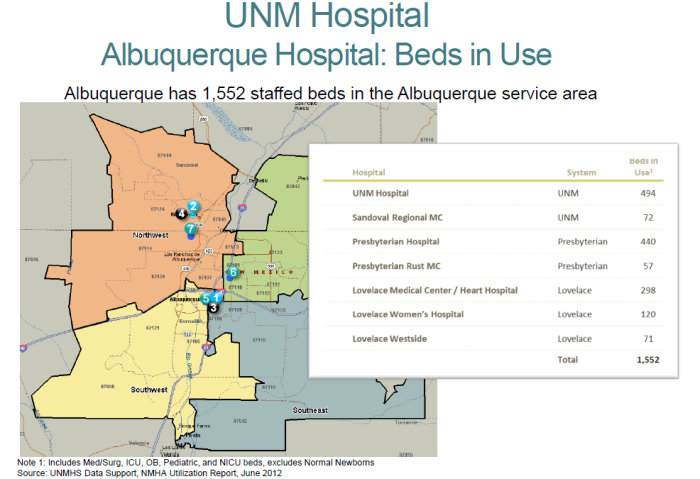By Alicia Padilla
ALBUQUERQUE, N.M. — At University of New Mexico Hospital (UNMH), patients spend an average of 16 hours in the emergency room before they’re admitted.
About an eighth of those patients leave the ER before being seen by a healthcare professional.
The findings, from a 2013 report, ranked UNMH fourth in the country for the longest ER wait times. UNMH is ranked seventh for most unseen patients. The report is published in the online magazine, HealthLeaders Media.
UNMH is the only level one trauma center in the state of New Mexico. Its mission is to provide high quality, comprehensive medical care for all patients, regardless of medical, financial, and social circumstances. Each year, UNMH treats 200,000 patients. The emergency department admits an average of 20 patients per day. As of October last year, the longest reported wait time for a hospital bed at UNMH was 34 hours.
The hospital’s urban location may have something to do with it. Data from the Centers for Disease Control and Prevention (CDC) revealed that average ER wait times have increased 25% since 2003, and patients, on average, waited longer to receive treatment from hospitals located in metropolitan areas.
The availability of hospital beds is a factor behind the figures. Nationally, NM is tied fourth with California and Nevada in having the fewest number of hospital beds per capita. With 300 adult medical surgical beds UNMH currently operates at 91% occupancy. According to the American Hospital Association (AHA) and the U.S. Department of Health and Human Services (HHS), UNMH should not exceed 75% occupancy.
An insufficient number of medical and surgical beds can be costly to patients’ health. After mistakenly being diagnosed with tuberculosis in 2008, University of New Mexico student, Govinda Schaefer has waited countless hours to see a physician at UNMH. He suggests UNMH opening a second ER where there’s not such a full waiting room.
“I noticed every time I’ve been there, there’s large amounts of people waiting to either see people or get seen,” Schaefer said.
In an attempt to curb ER wait times UNMH opened a 500,000 square foot emergency and clinical space pavilion in 2007. The pavilion features cutting-edge imaging, laboratory and surgical technology that are uniquely designed to configure medical efficiency and patient safety.
However, due to continued lack of space and capacity at UNMH, the state plans to build an accompanying 96 bed elective care hospital. The purpose for the expansion is to reduce ER wait times by freeing up bed and exam rooms, says Commissioner Wayne Johnson. The new facility would serve patients with elective or scheduled care services and will cost NM taxpayers $146 million dollars.
Other Albuquerque hospitals have taken effective steps to reduce their ER wait times. In July 2010, Presbyterian Hospital introduced a patient navigator system. The system consists of eight “navigators” that work to direct and assist ER patients to a proper primary care or urgent care provider when needed. The system decreases ER wait times and saves Presbyterian money in the process. By 2016, Presbyterian expects to save $10-$15 million dollars.
At Lovelace Medical Center and Lovelace Westside Hospital patients are seen by a medical professional within 30 minutes. In January 2011, Lovelace made subtle changes to staffing arrangements and routine tasks that were being duplicated by doctors and nurses. Implementing such changes curbed Lovelace’s ER wait times by 7-12 minutes.
Student Govinda Schaefer says UNMH might learn something from the other hospitals in town.
“If you can get faster treatment at [Lovelace] Women’s Hospital, other than the most popular and famous hospital in Albuquerque, then something must be changed,” Schaefer said.
Alicia Padilla is a student at the University of New Mexico where she is studying psychology and multimedia journalism.

















